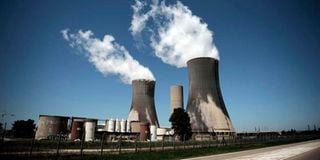Our nuclear dream was ill-timed

A file picture taken on July 9, 2008 shows French nuclear giant Areva' subsidiary Eurodif uranium enrichment plant in the Tricastin nuclear power center in Bollene, southern France.
What you need to know:
- Our main sources of energy have remained a lopsided mixture of expensive fossil fuels and hydro.
- It is said that Kenya has more electricity than it needs and won’t require any more for the foreseeable future.
At a time when the world’s attention is fixed on the need for clean fuel sources to ensure that humanity does not poison itself to extinction, at a time when every expert of note is warning that time is running out and something must be done to reduce carbon emissions by taking sensible measures like planting trees and not digging deep into the ground for dirty coal, it sounds strange to rail against one of the cleanest and boundless sources of energy – nuclear.
In the year 2008, our economic development planners, with a great deal of political will from far-sighted leaders, had a vision – to transform Kenya into a “newly-industrialising, middle-income nation providing a high quality of life to all its citizens in a clean and a secure environment by the year 2030”. Vision 2030 was a noble idea that was only, apparently, disrupted by the Covid-19 pandemic. It was also, of course, derailed by yet another slow-burning deterrent – endemic corruption.
Anyway, among its three pillars – economic, social and political – the economic was, to many, the most exciting: We would join the class of the two Asian Economic Tigers Kenya is usually compared with, South Korea and Singapore, mainly because in the early 1960s, we were on the same platform on matters GDP. Maybe it would have worked had our leaders chosen to go about it with the welfare of their fellow citizens in mind, but they didn’t. High-level sleaze started messing up everything and all that remained was the dream itself.
Apparently, it was assumed that by that magical year, Kenya would have joined the club of countries that possessed nuclear energy processing plants, and that at one point, we would have run out of the traditional sources of energy for manufacturing plants that would have sprouted up as a result of accelerated industrialisation. But that didn’t make sense then and still doesn’t today.
Solar and wind power
Kenya is blessed with many alternatives to fossil fuel on which we still almost exclusively rely today. It is a fact that solar and wind power sources have not been sufficiently exploited, while hydro-electricity, although a finite resource due to the ways we have despoiled our environment leading to the drying up of water sources, is also still under-exploited. On that note, it is a pity that when more dams are contemplated, they become feeding troughs for rent-seekers.
Therefore, our main sources of energy have remained a lopsided mixture of expensive fossil fuels and hydro. There has also been, in the past, the idea of importing coal from South Africa to set up a power-generation plant in Lamu, a ridiculous move that would have ended up polluting the environment in a major way. Thankfully, sense prevailed and the would-be multinational financiers pulled out after sustained opposition by local and international environmentalists.
In any case, it is said that Kenya has more electricity than it needs and won’t require any more for the foreseeable future. What should be done is to make it affordable to a lot more people by closing all the loopholes that force consumers to subsidise the already opulent livelihoods of power buccaneers. This essentially means that the last thing we need is a nuclear power plant that will probably not be necessary for the next 100 years, if at all.
It therefore came as a pleasant surprise when it was announced that the quest for this power source will be put on hold and the corporation charged with implementing it, the Nuclear Power and Energy Agency, dissolved. The country doesn’t need nuclear power any time soon, and any dream of importing reactors for the purpose should remain just that – a dream. Certainly, it would be relatively cheaper to fully exploit other clean energy options like solar and wind before venturing into uncharted waters.
***
From all appearances, the dreaded Corona is gone. Kaput. Banished from this dear land through presidential fiat. And it ain’t coming back no more. It met its Waterloo on October 20, Mashujaa Day, when the President lifted the disruptive nationwide curfew which had lasted a year and seven months. From the way Kenyans reacted to the announcement, he just fell short of declaring the virus illegal.
How do I know this? Just check it out; very few people are wearing face-masks any more – except in supermarkets and a few other places like banking halls – or even sanitising. And it appears they are all bent on playing catch-up with their buddies in social settings, especially pubs, by getting closer to each other than ever before, probably asking themselves what the social distancing fuss was all about in the first place.
Never mind that they were also advised not to drop their guard because the lull in infections may be only temporary. It looks like we Kenyans are living in a fools’ paradise if we believe our problems with Covid-19 are over and life will soon go back to normal. We are in this thing for the long haul and the sooner we accept that reality, the better.
Mr Ngwiri is a consultant editor. [email protected]





